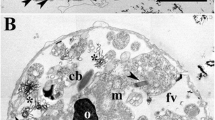Abstract
Marine tubificids are abundant and diverse in the carbonate sediments of Bermuda, as well as in many other tropical and subtropical locations. Recently, during microscopic observations of living specimens, crystal-like structures were observed attached to the coelomic peritoneum and in the coelomic cavity of some Bermuda species, including phallodrilines of the genera Aktedrilus and Pectinodrilus,and a rhyacodriline of the genus Heterodrilus. Similar structures were not seen in tubificid species of Thallasodrilides and other limnodriloidines, a second species of Heterodrilus, a tubificine of the genusTubificoides, a phallodriline of the genus Bathydrilus,nor in a number of marine enchytraeid genera and species found in Bermuda. The crystal-like structures have two needle arms, each about 5–10 μm long and about 0.5 μm in diameter, meeting at an obtuse angle. At the junction of the arms, there is a small membrane-bound `knob', about 1 μm in diameter, which may be continuous with the coelomic peritoneum. The numbers of `crystals' per individual worm are estimated at 100–400 per body segment, or well over 2 × 103 in an adult worm. `Crystals' are found: throughout the length of the worms, in all individuals of species in which `crystals' occur, and over the range of environmental conditions where these species are found in Bermuda. Simple digestions with hypochlorite, weak and dilute acids, and staining with nuclear and cytoplasmic stains indicate that the composition of the knob is organic and the arms inorganic. The fluorescent tracer Calcein (Sigma) was not incorporated into any structures during a 24-h bath incubation of living worms, and the `crystals' do not show birefringence when viewed between crossed polarizing filters. These last two results do not support an hypothesis that these are calcium carbonate `crystals'. Geographically, the crystal-like structures are widespread, and have also been observed in a species of immature (unidentified) marine tubificid from Rottnest Island, Western Australia.
Similar content being viewed by others
References
Erséus, C., 1990. The marine Tubificidae (Oligochaeta) of the barrier reef ecosystems at Carrie Bow Cay, Belize, and other parts of the Caribbean Sea, with descriptions of twenty-seven new species and revision of Heterodrilus, Thalassodrilides and Smithsonidrilus. Zool. Scr. 19: 243–303.
Erséus, C., T. Prestegaard & M. Kallersjo, 2000. Phylogenetic analysis of Tubificidae (Annelida, Clitellata) based on 18S rDNA sequences. Mol. Phylo. Evol. 15: 381–389.
Gibbs, B. E. & G. W. Bryan, 1984. Calcium phosphate granules in muscle cells of Nephtys (Annelida, Polychaeta) – a novel skeleton? Nature 310: 494–495.
Lacey, A. J., 1989. Rendering transparent specimens visible by inducing contrast. In Lacey, A. J. (ed.), Light Microscopy, a Practical Approach. IRL Press, Oxford: 25–59.
Lowenstam, H. A., 1981. Minerals formed by organisms. Science 211: 1126–1131.
Lowenstam, H. A. & S. Weiner, 1989. On Biomineralization. Oxford University Press, New York: 324 pp.
Milligan, M., 1996. Identification manual for the aquatic Oligochaeta of Florida. Vol. II. Estuarine and nearshore marine oligochaetes. Florida Department of environmental Protection, Tallahassee, Florida: 239 pp.
Pearse, V. B., T. Uehara & R. L. Miller, 1994. Birefringent granules in Placozoans (Trichoplax adhaerens). Trans. am. microsc. Soc. 113: 385–389.
Rowley, R. J. & D. I. MacKinnon, 1995. Use of the fluorescent marker calcein in biomineralization studies of brachiopods and other marine organisms. Bull. Inst. ocean. Monaco, 2 (special publication #14): 111–120.
Author information
Authors and Affiliations
Rights and permissions
About this article
Cite this article
Coates, K.A., Sorocco, D.A., Maturen, N. et al. Mysterious `crystals': found attached to the epidermal peritoneum of marine tubificid (Annelida, Clitellata) species. Hydrobiologia 463, 115–122 (2001). https://doi.org/10.1023/A:1013195306432
Issue Date:
DOI: https://doi.org/10.1023/A:1013195306432




